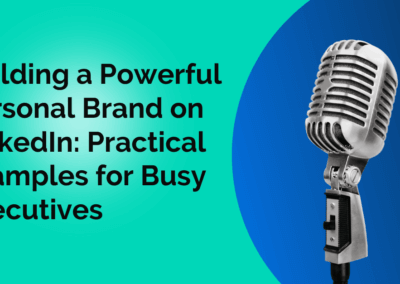Account-based marketing (ABM) is taking the industry by storm. In fact, according to a SiriusDecisions study, 93% of B2B marketing leaders say ABM is imperative to their strategy. Tired of creating content that no one reads and stepping on one another’s toes, marketing and sales teams have finally begun to focus on accounts they would like to win rather than single leads or general audiences.
Of course, ABM wasn’t always the rage. This type of marketing was started in 1993, when the landmark publication The One-to-One Future pushed for personalized marketing. After its introduction, audience-targeted marketing was used more and more until the phrase “account-based marketing” was finally coined in 2004 by ITSMA. As the need for inbound marketing grew (and continues to grow), ABM gained steam and vendors offering ABM solutions became more common.
From what we’ve seen in the past, we predict that ABM will go on to become more prominent as businesses work to streamline and further customize marketing tactics. That’s why we’ve compiled an extensive list of helpful account-based marketing tactics that will take you from planning to execution to measurement.
Planning Tactics
Arguably the most important step in your ABM strategy is planning your approach. With a strong foundation based on these account-based marketing planning tactics, your ABM strategy is far more likely to succeed.
Define your Ideal Client Profile
Choosing your ideal customer profile (ICP) is your most important task. Your sales and marketing teams must collaborate to ensure that the companies you will be targeting fit your solution. You’ll need to consider the firm’s firmographics data and business needs to make the right decision.
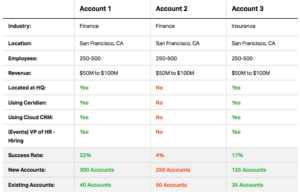
Source: Radius
Align sales and marketing teams
Ensuring your sales and marketing teams are on the same page is the key to your entire strategy. Read Agent3 CEO Clive Armitage’s steps to ensure alignment, which includes allowing both teams to contribute ideas, choosing target accounts together, and setting up a communications process for sharing project progress as well as results.
Choose an executive sponsor
Every account-based marketing strategy needs an executive sponsor. This team member champions and guides the project in a big-picture way, ensuring that both sales and marketing teams are on board and happy. Your executive sponsor can also sweep in and mediate an issue, close a deal, or offer valuable advice about any tough decisions you may need to make.
Organize account data in your CRM solution
Before you begin your ABM execution plan, your CRM data is probably lead-based or has some serious coverage gaps. You’ll need to change from lead-based reporting to a measurement structure based on accounts and contacts. This process will take some work, but there are some hacks you can use, courtesy of industry professional Lauren Frye.
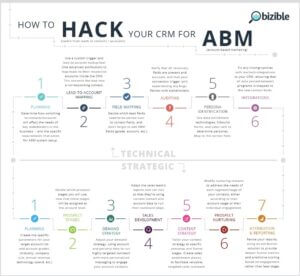
Source: ChiefMarTec
Gather and maintain clean data
Companies now have access to a lot of data—but if it isn’t clean, it’s worthless. Review existing data, checking for duplication and old data, and updating mission-critical fields like company name, email address, contact name, and title. Communicate standardized data entry requirements to your teams to avoid the need for cleanups in the future.
Identify buying signals and other data
Determine the signs that indicate a company might be in the market for your product. These triggers will mark the addition of a company to your target list or the start of a new phase in your ABM marketing campaign. Depending on your product, triggers range from office moves to leadership change, and can be automated.
Commit to target account pursuit channels
Once you lock in on target companies, decide which channels you’ll use to reach them. Consider various factors, like company culture and buyer personas. For technology startups, try Twitter mentions and targeted blog posts. For established corporations, segmented email campaigns and personalized direct mail may be more helpful.
Targeting and Engagement Tactics
Now we get to the bread and butter of account-based marketing tactics: engagement. This is the stuff marketers love—creating innovative content that strikes a chord with targeted accounts.

Source: Content Marketing Institute
Tag target accounts on social
Ninety percent of businesses use social media for marketing, meaning your target accounts are probably on a few channels themselves. Monitor social channels carefully, retweeting articles created by or mentioning the target account and tagging them when appropriate. Your target account is sure to notice and appreciate the amplification.
Feature target accounts within content
Everyone likes to be heralded as an expert. Next time you’re writing a blog post, use a target account as an example of an innovative industry leader. Once you have released the blog post, tag them on social channels to be sure they—and their extended network—get a look at your work.
Conduct a mini-survey
Ask a target account employee or leader to answer a mini-survey or interview for a blog post you’re creating. This win-win-win account-based marketing tactic will draw attention to your business, flatter your target, and provide you with research for a blog post.
Create a “State of” report or case study
In a similar vein, you can create an extended report about a target customer’s industry. You may either use the target account as an example, asking for interviews or advice, or you can use the report as a way to let your target account know that you’re an expert in their field who knows exactly what product might help them out.
Host a podcast series
If you’re looking for other content formats that will draw your target accounts in, branch out with a podcast. Create a specific theme and invite guests from your target accounts to weigh in with their industry tips and tricks. Be sure to follow up with the finished product—in shareable format so the interviewee will forward it to his or her boss.
Send personalized direct mail
Direct mail has a bad rap, but actually, it has a response rate thirty-six times higher than that of email. For the best results, personalize your direct mail (a classic account-based marketing tactic) and make sure the image is out-of-the-box and fun. This guide from direct mail guru enthusem will get you started.
Ship out gift boxes
If you have the cash to spare, personalized gifts are an excellent way to establish a connection with your target account. Since your gift recipients will almost certainly read your note to see who the gift is from, take the opportunity to include a personal note that shows you know their business needs. (Just make sure the gift is one they will really enjoy.)
Deploy retargeted social ads
Retargeted social ads allow you to send your ads directly to a list of targets—as long as those targets are connected to their social accounts by their work emails or company. Given that the click-through rate (CTR) of a retargeted ad is 10 times higher than the CTR of a typical display ad, it’s worth the risk. Check out this HubSpot guide for pointers.
Create personalized landing pages
We all know that personalized content yields better results. Personalized landing pages are a great way to drive even more leads. You can customize based on company—or the individual—level, using information from past visits, browsing history, in-session behavior, and third-party data to encourage more clicks.
Host sales dinners
Whether you’re hosting a one-on-one dinner or a small network cocktail gathering, you’ll find that salespeople rarely turn down free food and drinks. One thing: make sure your event is unique. Steak dinners are ordinary, but dinner at a cinema and restaurant combo? Legendary.
Run a roadshow
Personally contact target accounts to arrange your stops and before the event, ramp up excitement with hashtags and email campaigns so you’ll have a sizeable audience. Combine your spectacular roadshow presentation with a less salesy account-based marketing tactic, like a dinner, to even out the pitch. You’ll prove your product’s value and create a strong, trust-based relationship with your target account, ultimately encouraging future engagement.
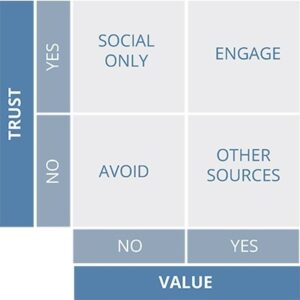
Source: B2B Marketing
Sponsor an event
Sponsoring an event that a target account cares about or will be attending is a sure way to gain entry into their hearts (and wallets). Whether you choose to make a public donation to their favorite nonprofit or provide free DJs for their rockin’ holiday party, you’ll catch their attention and their admiration, which might lead to a sale.
Participate in or host a roundtable
Most companies makes it public knowledge which industry conferences they’ll be attending. Once you know some of your target accounts will be at a certain location, try to attend a roundtable featuring one of your targets. There’s a good chance you’ll make strong connections and that other target accounts may be in the audience listening.
Measurement and Reporting Tactics
Measurement and reporting are vital to your ABM strategy. After all, how will you know whether your strategy is succeeding if you don’t measure your results? Here are the top measurement and reporting account-based marketing tactics for post-engagement use.
Track account coverage
You need to ensure all your target accounts are being engaged, and engaged thoroughly. Track factors such as the amount of research done on accounts, the number of accounts that have been engaged, and the number of contacts engaged within an account. Bizible offers a simple chart that may help guide your definition of success.
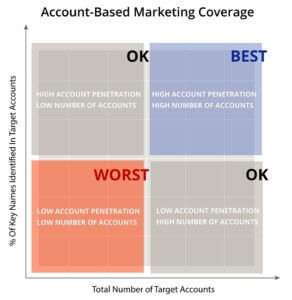
Source: Bizible
Trace account awareness
This metric can be measured by the amount of web traffic from targeted accounts, as brand Integrate notes, or views on social media ads. Though simple, account awareness is an important metric. Awareness is the first step in the customer journey—and an immediate precursor to engagement.
Measure account engagement
Ensure you track all relevant engagement metrics, including items like responses to personalized webpages, CTR on social ads, and event attendance. Though there are many opinions about ideal metrics, Engagio suggests that teams measure an account’s total minutes responding to marketing activities and engaging with sales teams.
Review conversion rates
In the planning stages, you will have determined what counts as “account conversion.” This is a vital item to measure, as it will determine your ultimate success. Because it is such an important metric, conversion rate is certainly one to review with your executive sponsor, who may have pointers regarding the best definition of this critical metric.
Gather results in regular reports
With ABM, regular reports are vital. Reports should be short and simple—something that employees can skim through and comprehend. The more obvious it is which areas need improvement, the more quickly your teams can take action. As B2B software brand Bizible notes, ABM measurement software can simplify the reporting process.
Communicate your results
At the end of the day, communication is key. Be sure that sales and marketing teams are sharing reports, making constant changes to improve their strategy, and keeping their eyes on the goals ahead.
Whether you are planning your ABM strategy or preparing a final report, we hope this list of account-based marketing tactics will be helpful well into 2019. And if you need help setting up any part of your strategy, we’re here to help.
Interested in learning more about ABM? Check out our blog post 5 Effective Account-Based Marketing Strategies For B2B Companies.


